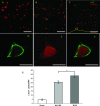Intracardiac injection of matrigel induces stem cell recruitment and improves cardiac functions in a rat myocardial infarction model
- PMID: 20477905
- PMCID: PMC4373331
- DOI: 10.1111/j.1582-4934.2010.01086.x
Intracardiac injection of matrigel induces stem cell recruitment and improves cardiac functions in a rat myocardial infarction model
Abstract
Matrigel promotes angiogenesis in the myocardium from ischemic injury and prevents remodelling of the left ventricle. We assessed the therapeutic efficacy of intracardiac matrigel injection and matrigel-mediated stem cell homing in a rat myocardial infarction (MI) model. Following MI, matrigel (250 μl) or phosphate-buffered solution (PBS) was delivered by intracardiac injection. Compared to the MI control group (MI-PBS), matrigel significantly improved left ventricular function (n= 11, P < 0.05) assessed by pressure-volume loops after 4 weeks. There is no significant difference in infarct size between MI-matrigel (MI-M; 21.48 ± 1.49%, n = 10) and MI-PBS hearts (20.98 ± 1.25%, n = 10). The infarct wall thickness of left ventricle is significantly higher (P < 0.01) in MI-M (0.72 ± 0.02 mm, n = 10) compared with MI-PBS (0.62 ± 0.02 mm, n = 10). MI-M hearts exhibited higher capillary density (border 130.8 ± 4.7 versus 115.4 ± 6.0, P < 0.05; vessels per high-power field [HPF; 400×], n = 6) than MI-PBS hearts. c-Kit(+) stem cells (38.3 ± 5.3 versus 25.7 ± 1.5 c-Kit(+) cells per HPF [630×], n = 5, P < 0.05) and CD34(+) cells (13.0 ± 1.51 versus 5.6 ± 0.68 CD34(+) cells per HPF [630×], n = 5, P < 0.01) were significantly more numerous in MI-M than in MI-PBS in the infarcted hearts (n = 5, P < 0.05). Intracardiac matrigel injection restores myocardial functions following MI, which may attribute to the improved recruitment of CD34(+) and c-Kit(+) stem cells.
© 2011 The Authors Journal of Cellular and Molecular Medicine © 2011 Foundation for Cellular and Molecular Medicine/Blackwell Publishing Ltd.
Figures





References
-
- Phillippi JA, Miller E, Weiss L, et al. Microenvironments engineered by inkjet bioprinting spatially direct adult stem cells toward muscle- and bone-like subpopulations. Stem Cells. 2008;26:127–34. - PubMed
-
- Furlani D, Li W, Pittermann E, et al. A transformed cell population derived from cultured mesenchymal stem cells has no functional effect after transplantation into the injured heart. Cell Transplant. 2009;18:319–31. - PubMed
-
- Minuth WW, Sittinger M, Kloth S. Tissue engineering: generation of differentiated artificial tissues for biomedical applications. Cell Tissue Res. 1998;291:1–11. - PubMed
-
- Kleinman HK, McGarvey ML, Liotta LA, et al. Isolation and characterization of type IV procollagen, laminin, and heparan sulfate proteoglycan from the EHS sarcoma. Biochemistry. 1982;21:6188–93. - PubMed
Publication types
MeSH terms
Substances
LinkOut - more resources
Full Text Sources
Medical

